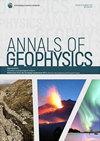FastVRP用于火山活动热监测的自动平台,使用VIIRS和SLSTR传感器:FastFRP用于监测火山辐射功率
IF 1.2
4区 地球科学
Q3 GEOCHEMISTRY & GEOPHYSICS
引用次数: 1
摘要
卫星热遥感被广泛用于探测和量化火山喷发过程中产生的高温火山特征,如释放的辐射功率。一些空间机构提供火焰辐射功率(FRP)产品来表征世界各地的任何热异常。特别是,可见光红外成像辐射计套件(VIIRS)的二级FRP产品和海陆表面温度辐射计(SLSTR)可以在线免费获得,它们可以监测与火山活动动力学相关的高温火山特征。在这里,我们提出了谷歌Colab开发的FastVRP平台,用于自动处理美国国家航空航天局(NASA)和欧洲航天局(ESA)空间机构提供的FRP产品。FastVRP旨在监测与埃特纳火山(意大利西西里岛)喷发活动相关的火山辐射功率(VRP)。我们比较了2021年2月至3月期间埃特纳火山最近发生的一些阵发性熔岩喷泉期间这些FRP产品的质量。我们强调了每种传感器在监测持续数小时的强烈火山喷发时的优点和局限性。此外,我们将中高空间/低时间分辨率的VIIRS和SLSTR与低空间-高时间分辨率的SEVIRI(旋转增强可见光和红外辐射计成像仪)结合起来,以改进每次发作事件释放能量的估计。特别地,我们提出了一种拟合方法来提高SEVIRI低空间-高时间分辨率测量的精度,利用在熔岩喷泉冷却阶段从VIIRS和SLSTR获取的少量高空间-低时间分辨率数据。我们用MODIS(中分辨率成像光谱仪)传感器获取的辐射功率值验证了从VIIRS和SLSTR预测的辐射功率值。本文章由计算机程序翻译,如有差异,请以英文原文为准。
The FastVRP automatic platform for the thermal monitoring of volcanic activity using VIIRS and SLSTR sensors: FastFRP to monitor volcanic radiative power
Satellite thermal remote sensing is widely used to detect and quantify the high-temperature vol- canic features produced during an eruption, e.g. released radiative power. Some space agencies provide Fire Radiative Power (FRP) Products to characterize any thermal anomaly around the world. In particular, Level-2 FRP Products of the Visible Infrared Imaging Radiometer Suite (VIIRS) and the Sea and Land Surface Temperature Radiometer (SLSTR) are freely available online and they allow to monitor high-temperature volcanic features related to the dynamics of volcanic activity. Here, we propose the FastVRP platform developed in Google Colab to process automatically the FRP Products provided by the National Aeronautics and Space Administration (NASA) and the European Space Agency (ESA) space agencies. FastVRP was designed to monitor the volcanic radiative power (VRP) related to eruptive activity of Mt. Etna (Sicily, Italy). We compared the quality of these FRP Products during a number of recent paroxysmal lava fountains occurred at Etna volcano between February and March 2021. We highlighted the advantages and the limits of each sensor in monitor- ing intense volcanic eruptions lasting a few hours. Furthermore, we combine the mid-high spatial/ low temporal resolution VIIRS and SLSTR with the low spatial-high temporal resolution SEVIRI (Spinning Enhanced Visible and Infrared Radiometer Imager) to improve estimates of the energies released from each paroxysmal episode. In particular, we propose a fitting approach to enhance the accuracy of SEVIRI low spatial-high temporal resolution measurements exploiting the few acqui- sitions from VIIRS and SLSTR high spatial-low temporal resolution during lava fountain cooling phase. We validated the radiative power values forecasted from VIIRS and SLSTR with the radiative power values retrieved using MODIS (Moderate Resolution Imaging Spectroradiometer) sensor.
求助全文
通过发布文献求助,成功后即可免费获取论文全文。
去求助
来源期刊

Annals of Geophysics
地学-地球化学与地球物理
CiteScore
2.40
自引率
0.00%
发文量
38
审稿时长
4-8 weeks
期刊介绍:
Annals of Geophysics is an international, peer-reviewed, open-access, online journal. Annals of Geophysics welcomes contributions on primary research on Seismology, Geodesy, Volcanology, Physics and Chemistry of the Earth, Oceanography and Climatology, Geomagnetism and Paleomagnetism, Geodynamics and Tectonophysics, Physics and Chemistry of the Atmosphere.
It provides:
-Open-access, freely accessible online (authors retain copyright)
-Fast publication times
-Peer review by expert, practicing researchers
-Free of charge publication
-Post-publication tools to indicate quality and impact
-Worldwide media coverage.
Annals of Geophysics is published by Istituto Nazionale di Geofisica e Vulcanologia (INGV), nonprofit public research institution.
 求助内容:
求助内容: 应助结果提醒方式:
应助结果提醒方式:


